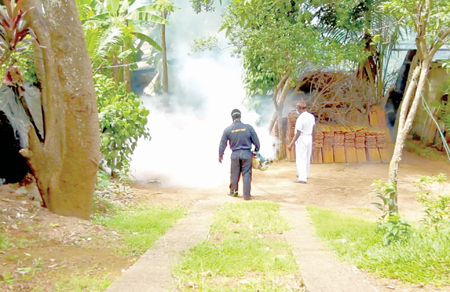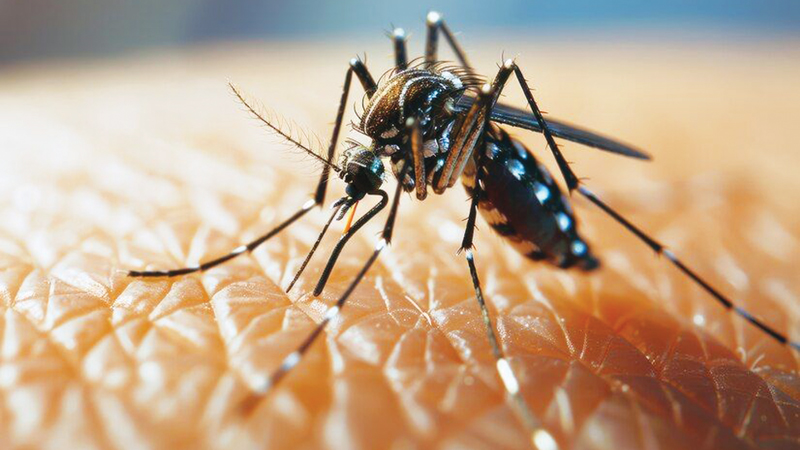 As Sri Lanka deals with a dengue epidemic, expert public health officials must approach the battle against infectious diseases.
As Sri Lanka deals with a dengue epidemic, expert public health officials must approach the battle against infectious diseases.
Prof. Neelika Malavige of the Department of Immunology and Molecular Medicine, said that the rapid rise of obesity, diabetes, and related metabolic disorders is intimately connected to the growing toll of dengue and other viral diseases such as Chikungunya. The fight against non-communicable diseases (NCDs) is no longer just about preventing heart attacks or strokes. It has become a critical frontline in managing, and mitigating, the devastation of infectious illnesses, especially dengue.
The research journey: Narrowing the focus
Sri Lankan scientists who work on infectious diseases face a landscape where dengue is an ever-present public health emergency. Dengue like illness has been recorded in Sri Lanka since the beginning of the century, and it was serologically confirmed in 1962. Following a Chikungunya outbreak in 1965, there was an island-wide epidemic of dengue with 51 cases of dengue haemorrhagic fever and 15 deaths in 1965 – 1968. From 1969 up to 1988, multiple dengue serotypes circulated in urban areas with endemic dengue fever, but there were only occasional cases of dengue haemorrhagic fever.
 However, from 1989, dengue haemorrhagic fever became endemic in Sri Lanka. According to a WHO report, in 1990, there were 1,350 suspected haemorrhagic fever cases, of whom 363 were serologically confirmed, and there were 54 deaths. The largest outbreak due to dengue was reported in 2017 with 186,101 cases. In 2023, there were over 89,000 cases of dengue.
However, from 1989, dengue haemorrhagic fever became endemic in Sri Lanka. According to a WHO report, in 1990, there were 1,350 suspected haemorrhagic fever cases, of whom 363 were serologically confirmed, and there were 54 deaths. The largest outbreak due to dengue was reported in 2017 with 186,101 cases. In 2023, there were over 89,000 cases of dengue.
Prof. Malavige said that many talented Sri Lankan scientists have been working on dengue for decades and that she has been interested in central, still poorly answered questions: why do some people develop severe dengue, specifically, dengue haemorrhagic fever, while most people infected with the virus experience only mild symptoms or none at all? And, crucially, what is different about the immune response in those who stay well?
Why do only some people develop severe dengue?
These foundational questions have animated the research agenda in Prof. Malavige’s laboratory for over a decade. The answers, she said, are not as simple as matching symptoms to virus types. Dengue, unlike Covid-19, is caused by four separate viruses, not just one with many variants. “There are four different types of dengue viruses,” she says. “Now, these are completely four different viruses. After you get infected with one virus, then you can get infected with another and another.”
But infection with a second or even third dengue virus does not guarantee severe illness. In fact, the vast majority of people, even after multiple infections, recover without incident. “Any of the four viruses can cause haemorrhagic fever,” Prof. Malavige said. “But the chances are more after the first infection, with subsequent infections. Still, most people are fine.”
This led to a critical insight, i.e., the major determinant of severe disease is not the virus itself, but how the individual’s immune system reacts. “The same virus infects people, but some develop dengue haemorrhagic fever because the body responds in a detrimental way.” The immune response, in other words, can be protective or destructive.
This finding mirrors what was observed with Covid-19. The majority of people exposed to SARS-CoV-2 suffered little or no illness, but a minority experienced life-threatening complications because of their body’s immune response. “It’s similar to dengue,” Prof. Malavige says. “A lot has to do with how you respond to the virus.”
Still, there are differences in how “nasty” certain dengue strains can be, but even those do not always cause severe outcomes. The search for answers, then, revolves around understanding the host response, what makes some immune systems misfire in the presence of the virus?
Mapping dengue exposure across Sri Lanka

Prof. Neelika Malavige
To understand the spread and risk of dengue across Sri Lanka, Prof. Malavige’s group undertook a island-wide survey. This effort revealed a picture of striking geographic diversity. In the metropolitan Colombo district, around 70 percent of children are exposed to dengue by the age of 17. In contrast, in Nuwara Eliya and Badulla, the figure is just 13 percent, with Polonnaruwa at 25 percent and Matara similarly low. “People think there is a lot of dengue in places such as Polonnaruwa and Anuradhapura. This is not true, she said. Dengue is often an urban disease and most places in Sri Lanka are rural.
These findings have enormous implications for public health. They directly affect the viability of mass vaccination campaigns, which are only suitable in areas with consistently high transmission. On the other hand, administration of the vaccine to children who had not been exposed to the virus can increase their chances of developing serious reaction to dengue once infected. The example of the Dengvaxia vaccine, which increased the risk of severe dengue in children not previously infected, was a hard lesson.
“If the vaccine causes more severe disease, you don’t want the vaccine,” Prof. Malavige said. As such, current WHO guidance for new vaccines such as Takeda’s is to restrict their use to high-transmission areas, a policy only possible with detailed local epidemiology.
“You can’t look at Colombo alone and say so let’s vaccinate everybody. So with a 70 percent exposure rate, a vaccine maybe suitable for Colombo, but not for the rest of Sri Lanka. But you can’t also just vaccinate children in Colombo because there would be an uproar. That’s why we needed to do that study,” she said.
But as the number of dengue cases continue to rise sharply not only in Sri Lanka but across Asia, it is clear that exposure was not driving increased hospitalisations. Something else is driving the increase in hospitalisations and severe outcomes.
Obesity and diabetes: Hidden accelerants of the dengue epidemic
Prof. Malavige’s team, looking for additional explanations, turned to another rapidly changing factor in Sri Lankan society, i.e., the dramatic rise in obesity and diabetes. These metabolic disorders, already a crisis in their own right, appear to be a major accelerant of the dengue burden.
From a large island-wide study involving over 5,000 children, the team found a clear correlation: “Children who were quite obese were twice as likely to be hospitalised than children who were not obese,” Prof. Malavige says.
The association holds true for adults. Among South Asians, standard BMI measurements often miss high body fat because of generally lower muscle mass. Many adults are “skinny fat,” i.e., they have normal BMI but with a lot of body fat, sometimes exceeding 30 percent.
“Fat is very active tissue, which produces a lot of inflammation. The fat that is usually in your subcutaneous tissues, the layer of fat and connective tissue beneath the skin but above the muscles, is not that bad. However, visceral fat, is bad fat. Visceral fat is found deep within your abdominal cavity. It surrounds important organs, including your stomach, liver and intestines,” she said.
Another important concept is, central obesity that means the excessive accumulation of visceral fat, primarily in the abdominal area. In their study, Prof. Malavige and her colleagues defined central obesity by a waist circumference over 80 centimetres in women and 90 in men. Visceral fat, which accumulates deep in the abdomen around vital organs, acts not as a passive store but as a highly active endocrine organ, pumping out inflammatory mediators that compromise the body’s response to infections. “People who had more visceral fat were much more likely to have higher liver damage and more severe dengue,” Prof. Malavige added.
These findings change the arithmetic of infectious diseases. In a hypothetical community of 100 people, if all are exposed to dengue, but only 25 percent show symptoms, the burden on hospitals is limited. But as obesity and diabetes rates rise, the symptomatic-to-asymptomatic ratio also rises. Instead of 25 people requiring care, it might be 50. The number of people needing medical attention doubles, not because more people are getting infected, but because more are suffering severe consequences.
This effect extends to other infectious diseases as well. People with metabolic disorders not only do worse with dengue but also with Covid-19, influenza, and many other infections. The lines between infectious and non-communicable diseases have become blurred. “Comorbidities are now a critical factor in infectious disease outcomes,” Prof. Malavige says. “We must control comorbidities, not just because of cardiovascular disease, but because they amplify the severity of infections.”
A wider public health crisis: Diet, sleep, poverty and opportunity
 The roots of Sri Lanka’s metabolic health crisis are complex and intertwined with broader societal challenges. In some communities, as 72 percent of women over 50 are diabetic, and over half of adults of that age have central obesity. These trends are most pronounced in lower socio-economic groups, where limited space, poor diet, and chronic stress conspire to make healthy living nearly impossible.
The roots of Sri Lanka’s metabolic health crisis are complex and intertwined with broader societal challenges. In some communities, as 72 percent of women over 50 are diabetic, and over half of adults of that age have central obesity. These trends are most pronounced in lower socio-economic groups, where limited space, poor diet, and chronic stress conspire to make healthy living nearly impossible.
“There is no exercise culture,” Prof. Malavige said. “If you look at all the European countries, they have a culture of exercising. Like us, they were once farming communities, and now they are doing desk jobs. They know the sedentary lifestyle leads to disease, and most people take measures to exercise. Here, we are on the same trajectory, but we don’t exercise. The Government needs to step in.”
Dietary patterns are another driver. The traditional Sri Lankan diet, once rich in vitamins, fibre and nutrients, is giving way to processed foods lacking in nutritional value. Lack of sleep, common in urban and impoverished communities, further weakens immune defences. All these factors influence the body’s microbiome, which plays a direct role in immune function and disease susceptibility.
Implications for dengue control: Moving beyond mosquito nets
Sri Lanka’s dengue strategy has historically focused on vector control, destroying mosquito breeding sites, deploying fumigation, and, more recently, vaccination. But as Prof. Malavige’s research shows, this is no longer enough. The rise of metabolic diseases has created a “hidden time-bomb” that is dramatically amplifying the impact of dengue.
Controlling obesity, diabetes, and related conditions is now as critical to infectious disease prevention as any traditional public health measure. Prof. Malavige is unequivocal: “To reduce the impact of dengue, we need to look at all these things.” Efforts must target the entire spectrum: from encouraging exercise, improving food quality, and promoting better sleep, to designing health interventions that take into account the complex social determinants of disease.
Looking ahead: The need for urgent, holistic action
The research group at the University of Sri Jayewardenepura continues to track communities over time, examining how changes in metabolic health and immune responses shape susceptibility to dengue and other diseases. The evidence is sobering. In many areas, the combination of poverty, poor diet, and lack of exercise is producing a generation at risk of never reaching old age. “Most of the younger generation will not live to 60 unless drastic changes are made,” Prof. Malavige said. “People are now having heart attacks in their 30s; they will definitely have heart attacks in their 40s and 50s. The same with cancers and infectious diseases.”
Government action is essential. Creating opportunities for physical activity, ensuring access to healthy foods, and supporting communities to make lasting lifestyle changes are now as urgent as deploying new vaccines or insecticides. For Sri Lanka, and indeed for much of South Asia, the road to dengue control runs through the heart of the metabolic epidemic.
The new front in public health
The story of dengue in Sri Lanka is no longer just about mosquitoes, viruses, or even the immune system in isolation. It is about the intersection of infectious and non-communicable diseases, about how rising rates of obesity and diabetes are fundamentally changing the landscape of risk and resilience. The challenge, and the opportunity, lies in confronting these trends together. “The Government has to step in,” Prof. Malavige says. “We must target non-communicable diseases, obesity, diabetes. Not just for cardiovascular health, but because it is now an infectious disease strategy as well.”
For Sri Lanka, and for any society facing the twin threats of metabolic and infectious disease, the message could not be clearer. The next phase of dengue control, and perhaps of public health more broadly, will be won, or lost, on the battlegrounds of diet, exercise, sleep and social wellbeing as much as in the laboratory or the hospital ward.
Sri Lanka’s escalating dengue epidemic is no longer simply a story of mosquitoes and monsoon rains. Researchers now warn that the country’s surging rates of obesity, diabetes and other metabolic disorders are quietly turning routine infections into life-threatening illnesses, overwhelming hospitals and stretching public-health budgets. Immunologist Prof. Neelika Malavige, who has tracked dengue for decades, says a number of factors, including obesity, prime the immune system for damaging overreactions, doubling hospitalisation rates in obese children and driving severe complications in adults. Controlling non-communicable diseases, she says, is now inseparable from any dengue-control strategy.









